AMD Announces Carrizo and Carrizo-L, Next Gen APUs for H1 2015
by Ian Cutress on November 20, 2014 5:45 PM EST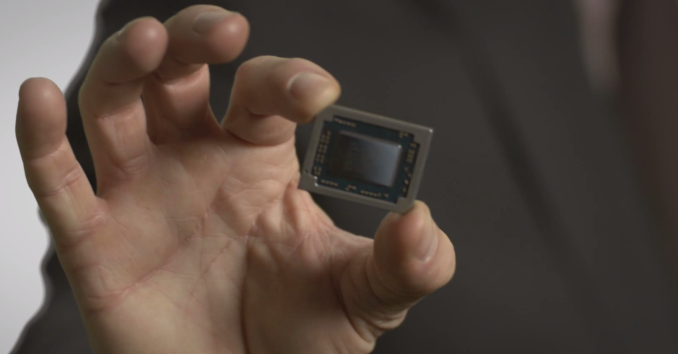
Today AMD is announcing the long anticipated upgrade to Kaveri, codenamed Carrizo. Carrizo is the natural successor to Kaveri, featuring x86 ‘Excavator’ cores alongside a Radeon-class GPU and promising an increase in performance all around. The second part of today’s announcement is for Carrizo-L, an SoC pairing “Puma+” (upgraded Beema) cores also with AMD’s R-series GCN GPUs and a FCH into a single package. Both Carrizo and Carrizo-L will feature ARM Trustzone, giving potential hardware-based built-in security when used by developers.
The Excavator cores are an architectural improvement over Steamroller, but are fundamentally based on the original Bulldozer concept. Excavator will be AMD’s fourth iteration of the concept, following Bulldozer, Piledriver and Steamroller. This new generation of APUs are still set to be built on the 28nm Super High Performance process at Global Foundries, delaying AMD’s shift to 20nm, but AMD are still claiming that the new GPU in Carrizo is their best yet, giving better performance and efficiency than before.
Given AMD's discrete GPU lineup, the GPU for Carrizo could be based on AMD's latest GCN 1.2 architecture, which was first introduced in the desktop Tonga part earlier this year. GCN 1.2's lossless delta color compression algorithms help improve the performance in memory bandwidth limited scenarios, such as in APUs. This could result in a bigger-than-expected jump in performance, although we will wait until we can test to find out how much it helps.
The Carrizo platform will be fully HSA 1.0 compliant, compared to Kaveri which only had ‘HSA Features’, as AMD puts it in their latest mobility roadmap update:
The push from AMD into HSA compliant APUs was well documented back at the launch of Kaveri earlier this year. This enabled the CPU and GPU components of the silicon, while under OpenCL 2.0 mode, to have access to the main block of system DRAM with zero-time copy functions, offering the potential for large classes of applications especially those in the prosumer and industry space to be accelerated by having instant access to the parallelization afforded by the GCN GPU. One of the big drawbacks of being an earlier adopter to HSA, as we noted at the time, was that software developers required time to bring their code to market, as well as AMD having to go out and teach the developers how to cater for HSA topology.
Both Carrizo and Carrizo-L on the mobile side will be targeted at the same power bands as Kaveri and Beema, although the socket will be new. The use of FP4 BGA also indicates that a single socket will cater for both the Excavator and Puma+ based APUs and would be interchangeable. A video by AMD’s VP/GM for Computing and Graphics, John Byrne, states that Carrizo and Carrizo-L are currently being tested internally ready for a 1H 2015 release, along with support for DirectX 12, OpenCL 2.0, Mantle and Freesync.
One of the big features that AMD is pushing with Carrizo is energy efficiency, with it being a keystone of the message. Because AMD have been on the same process node for a short while, they have to essentially follow the Maxwell example, by providing more performance for less power without the advantage of shrinking resistors. We were provided with an energy efficiency roadmap as well, showing the different methods AMD is using to achieve this:
One example of the efficiency improvement was provided by AMD’s Voltage Adaptive Operation. Rather than compensate for voltage variations which wastes energy, this technology takes the average operating voltage and detects when the voltage increases beyond a smaller margin. To compensate for this increase, the CPU speed is reduced until the voltage drops below the threshold and then the CPU speed is moved back up.
The changes in speed are designed to be so minute that it does not affect overall performance, however it might only take an errant voltage delivery component to consistently make the voltage go above that threshold, causing erratic slowdown that might be statistically significant. It will be interesting to see how AMD implements the latest version of this feature.
The 2015 desktop roadmap remains unpublished so far. AMD’s perception of a mobile-focused strategy would tend to suggest that the mobile comes first, with desktop following behind, although at this point it is unclear. A number of AMD’s marketing materials with this launch gave examples of the use of Carrizo and HSA for the prosumer, indicating that a desktop version should be announced in due course.
As of yet there was no discussion on the APUs to be launched, the speeds or the capabilities. All the roadmap tells us is 'up to four cores' (Excavator for Carrizo, Puma+ for Carrizo-L), some GCN compute units and 10-45W overall. There is no mention of DDR4 support, although the timeframe might be relevant for AMD to make the jump. Given the launch is still at least two quarters away, I would expect better details in due course. That timeframe fits in nicely around or just after Computex, perhaps indicating more details then.
Source: AMD


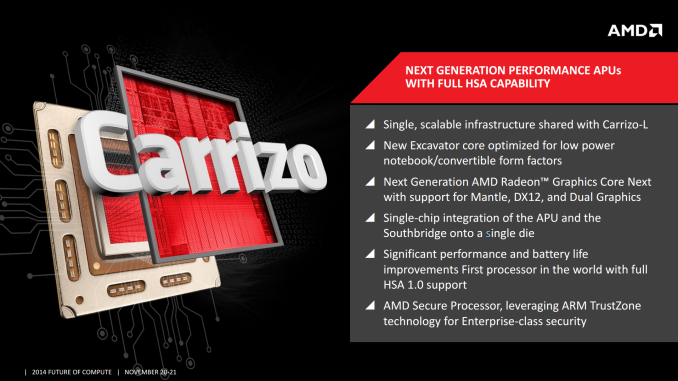
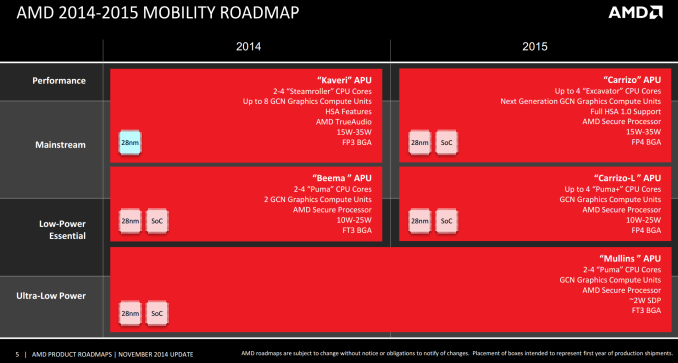
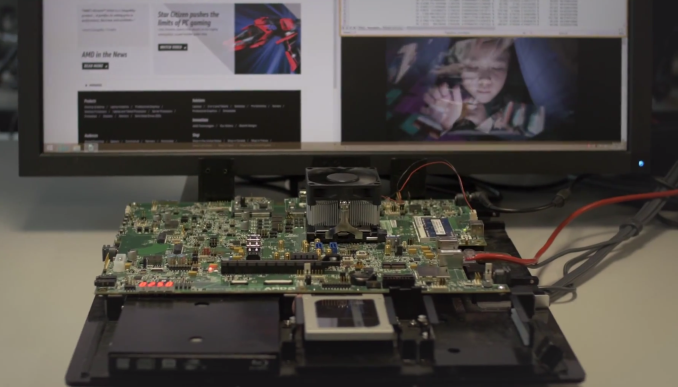
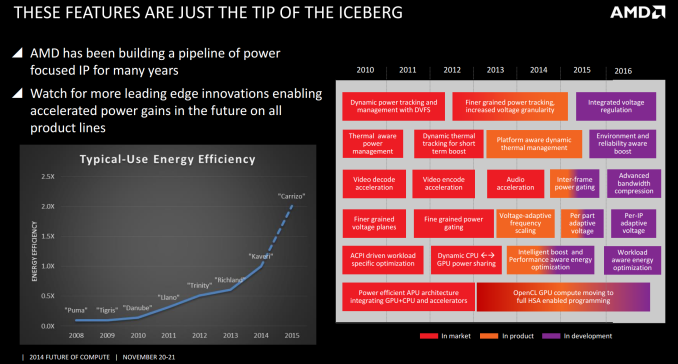
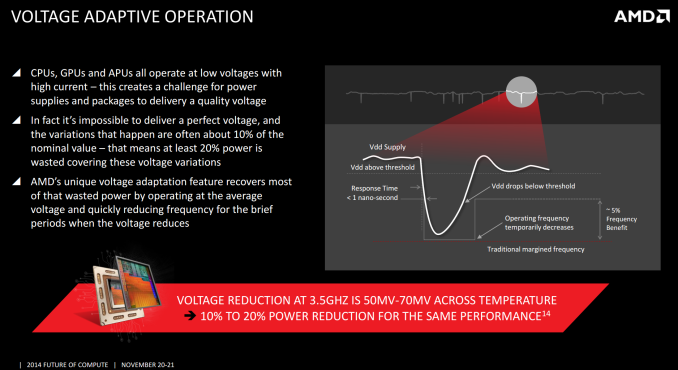
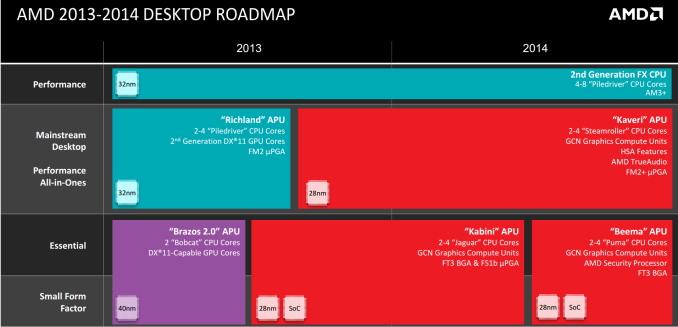








94 Comments
View All Comments
Gadgety - Friday, November 21, 2014 - link
Better graphics for smaller form factor at a cheaper price.sonicmerlin - Thursday, November 20, 2014 - link
Are they ever going to move beyond Bulldozer?JDG1980 - Thursday, November 20, 2014 - link
The new x86 core "Zen" is supposed to be coming in 2016. This is a ground-up design. They know Bulldozer is a dead end; Rory Read admitted as much, not long before being let go.Gadgety - Friday, November 21, 2014 - link
Exactly.Laststop311 - Thursday, November 20, 2014 - link
I hear ya man. Bulldozer was a failure since day 1. The fake cores suck. They say they have 8 core chips when really its 4 full cores and then 4 more cores with only half the parts of a core. They continue to stretch it with steamroller piledriver excavator and from the outside each iteration seems to bring no meaningful performance gains. After bulldozer flopped they should of instantly started working on a totally new architecture instead of wasting time reiterating a hugely failed one.If it wasn't for amd scoring the video game consoles they would be massively bleeding money. Now that both consoles have sold over 10 million units though expect console sales to get dramatically slower after this holiday as most people that want one already have 1.
What I have said before, The gpu part in the ps4 apu is much more powerful than any apu they offer for pc building. The 8 jaguar cores are really weak though. If amd just released an apu with the full ps4 gpu side fully enabled which is the same amount of cores as a desktop 7870 and instead of using crappy jaguar cores use 4 excavator cores that can atleast do some work they could have a real winner of a chip. They could even take it a step further and make an even bigger gpu than the ps4's apu. They already made a full 7870 inside an apu so maybe they could make a full or close to full r9 285 inside an apu + the 4 normal power excavator cores. Sure the die would be really big but considering they have been on 28nm so long the defect rate should be incredibly low right now so going with a huge die shouldn't be too risky. Making a bold product like that is exactly what amd needs to get noticed again. SFF desktops are really hot right now + HTPC's people would be lining up to put a gpu powerhouse apu like that in a system like that. Then they could scale it down for laptop use. I know a lot of people that would jump on a r9 285 or close to r9 285 inside an apu (just lower clocks than the discrete gpu)
Laststop311 - Thursday, November 20, 2014 - link
if amd can put a 20CU count full 7870 inside the ps4 apu (just lower clocks than the desktop gpu) than there is no reason they cant put a full r9 285 (just lower clocks then desktop gpu) inside a PC apu. Yes with a large die there are more chances for defects but with the incredible mature 28nm process like i said defects would be low and they could just offer 2 or 3 different chips with the defect cores fused off and made into lower end chips. With that powerful of a gpu inside an apu people would pay a much higher price for it since they arent buying a discrete gpu anymore.Laststop311 - Thursday, November 20, 2014 - link
if amd continues with these crappy releases over and over they will start losing money now that consoles will start slowing down in sales. They will continue to lose money every quarter until they are bankrupt and gone. They need to take a risk and put a huge GPU inside an apu and blow every 1;s minds.tuxfool - Wednesday, November 26, 2014 - link
Which would be incompatible with current DDR3/4 memory architectures on x86. Unless the motherboard offered a special pool of fast memory for the gpu it would be pointless to put that many CUs on the APU as they would be utterly bandwidth starved.mr_tawan - Friday, November 21, 2014 - link
What is fake core, btw? Is is just some pile of sand sitting in the die doing nothing ?Flunk - Friday, November 21, 2014 - link
Bulldozer cores have two integer units and one floating-point unit. This puts them somewhere between two actual cores and Intel's hyperthreading system for 2-threads per core performance. Because of this AMD markets them as 2 cores each, so what AMD claims is a 8-core chip only actually has 4-cores. This is somewhat disingenuous, which is why the OP calls them "fake cores".I don't think it's AMD's biggest hurdle, however. That would be Bulldozer (and it's derivatives) horrible single-thread performance. It's really disappointing after AMD ruling x86 performance for years (during the Athlon XP and Athlon 64 generations). All the fusion chips have been ok budget chips, but they really don't have anything high-end anymore.